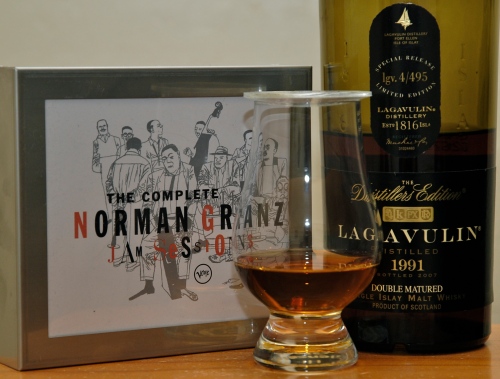 Introduction and book synopsis
Introduction and book synopsis
If you drink scotch and enjoy listening to jazz, you don’t need a book to tell you the two go great together. You might, however, be interested in a book that offers up large, artistic renderings of some of your favorite jazz musicians and scotch distilleries, provides deeper insight into the connections between jazz and whisky, and imparts historical knowledge in a way that both entertains and inspires creative thought. Enter Whisky & Jazz by Hans Offringa, available by mail order from Charleston Mercury (a South Carolina newspaper) for $39.95 plus shipping.
The marketing blurb for Whisky & Jazz on the Charlston Mercury site says:
“Hans Offringa, whisky writer for the Charleston Mercury, ingeniously connects ten famous jazz musicians with ten excellent single malt whiskies. The result is a collection of ten unique blends, each carrying a blue note as well as a tasting note, presented in a sippin’ and tasting guide.”
I was willing to buy the book based on the promise of some great pictures for the coffee table, the hope that this correlation between 10 whiskies and jazz songs would be interesting, and the fact that it was recommended by Serge of Whiskyfun.com. However, the book offers much more than I expected, making for a pleasant surprise when I started leafing through it. I’d like to try sharing a little more about the book so that you can see why I think it’s easily worth the $40 asking price.
Book layout and content
Whisky & Jazz is a good sized “coffee table book” with a little over 200 8.5″ x 11″ pages, about half of which contain full-page and double-page pictures. There is a Forward by Dave Broom (prominent whisky writer) with his own take on the whisky and jazz combination, then an Introduction by Offringa, where he sets up the book and dedicates it to his friend Michael Jackson (the whisky writer, not the pop star).
After the introductory material, there is a section titled The Origins of Jazz, which, in addition to telling the story of the origination of jazz, explains the etymology (breaking jazz down into its component parts), and then details three principal characteristics of jazz music. The next section, The Origins of Whisky, is also divided into origins, etymology and principal characteristics. Hats off to Mr. Offringa for managing to tie the two topics together through history and traits, without it seeming overly contrived in order to push his blending agenda.
Next, we have The Musicians and The Distilleries, with two or three pages (and as many pictures) on each musician and distillery, telling their story, and what makes them unique. I haven’t read all 20 of these yet, but the ones I have read were informative and entertaining. This material is well thought-out and clearly presented, not just a bunch of fluff to fill in between the pictures. There are all kinds of interesting tidbits…did you know about the Glenrothes “Toast to the Ghost”, or that the Stan Getz collaboration with Joao and Astrud Gilberto ended after Getz and Astrud had an affair?
The 10 musicians detailed in the book are: Cannonball Adderley, Chet Baker, John Coltrane, Miles Davis, Stan Getz, Dexter Gordon, Milt Jackson, Hank Mobley, Charlie Parker, and Art Tatum.
The 10 distilleries are: Aberfeldy, Balblair, Bowmore, Bruichladdich, Bunahabhain, Glen Rothes, Isle of Jura, Lagavulin, Oban and Springbank.
Finally, we have The Blends, a subjective “listening and sippin’ guide” in which Mr. Offringa concocts “blends” composed of individual musicians and individual expressions of single malts. He acknowledges that these are subjective pairings, and encourages the reader to experiment on their own (in moderation). For each jazz/whisky blend, there is a one page summary providing:
- A creative name for the blend
- A “Blue Note”, with a paragraph each on the artist and whisky, tying them together
- The blend “ingredients” (a specific expression and song)
- Tasting notes – a blend of notes by Offringa and Michael Jackson.
Conclusion and credits
As you could tell by the time you finished reading the title of this post, I highly recommend this book by Hans Offringa. Jack McCray, a jazz historian and freelance writer, is credited as contributing editor on the book. On the book jacket, it says about Mr. McCray…”aspires to present ideas in a clear, resonant and consise style that would impart information in a meaningful way to the reader.” Whatever his influence on this book, he and the author have certainly succeeded in those aspirations. Gijs Dragt, who has apparently designed a large number of books for museums, provided most of the eye candy for Whisky & Jazz, and it’s quite the photographic treat.
Links
- Hans Offringa, guest blogger – Hans guest blogs on The Book Case blog, providing great background information on himself and the series of books that he’s working on. Check it out!
- Hans Offringa’s web site – Hans’ official site, with links to more info about Whisky & Jazz and his other books.
- Whisky & Jazz – A web site dedicated to this book, including a links [spoiler alert] page that lists the jazz/whisky combinations that make up his blends.
- The Whisky Couple – Hans and his wife Becky are known as “The Whisky Couple.” Here is their web site. Right now, it includes a video from a Whisky & Jazz book signing and whisky tasting event.
- WHISKYFUN.COM by Serge – A much more eloquent review and recommendation than I’ve offered (scroll down a little bit).
- Accidental Hedonist review – A reminder that whisky and jazz are about enjoyment and spending time with friends, not sitting at home taking notes, and a recommendation for Offringa’s Whisky & Jazz and Taste of Whisky books.



